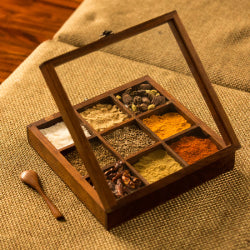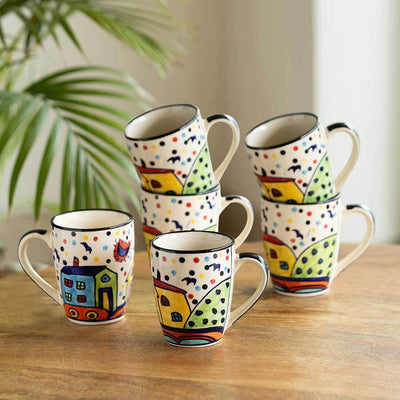The Beauty and Importance of Terracotta Pottery
Terra cotta or terra-cotta, generally known as Terracotta, translates to “baked earth” in Italian. One of the perfect definitions for, what is terracotta made of? Therefore, terracotta can be understood as earthenware, a ceramic made from clay. This ceramic could be glazed or unglazed. The origin of terracotta is generally used for sculptures made in stoneware and even for several practical uses such as vessels or flower pots, wastewater and regular water pipes, bricks, roofing tiles, and embellished surfaces in building constructions. This term also refers to the typical brownish-orange colour of terracotta pottery.
History and Importance of Terracotta pottery
Prehistoric art was one of its first sources of inspiration, with some of the world's oldest ceramics dating back to 24,000 BC. Interestingly, rather than cooking pots, these early pieces were discovered to be Palaeolithic terracotta figures, illustrating how far terracotta has been utilised in the art. China's Terracotta Army, a stunning collection of terracotta figures of over 8,000 warriors and 520 horses, is perhaps the most recognised usage of terracotta in art. It was unearthed in the mausoleum of China's First Emperor, Emperor Qin Shi Huang (246 to 208 BCE, but not discovered until 1974 by local Chinese farmers). Terracotta is popular for sculpting because of its thick, pliable texture and simplicity of moulding. It's a lot easier to deal with than marble or copper, for example. Terracotta is also extensively used in architecture, most notably in roof tiles and brickwork, due to its extreme durability, gorgeous colour, and low cost of production.
It's also a building material with a lesser fire danger. Terracotta is also often utilised in the production of flowerpots and very ornate dining plates.
Source: https://www.thesprucecrafts.com/all-about-terracotta-4152002
How Terracotta Pottery Is Made
Terracotta is a versatile material to work with. Pieces can be created using either a "additive" technique, which involves adding clay to the growing pieces, or a "subtractive" technique, which involves carving a solid lump with a knife or other instrument. The most typical combination of these is to build up the broad shape first, then remove or add pieces to make details.
The most typical way of manufacture is to use a finely refined clay and shape it to the desired shape. It could also be built using one or more moulds. After drying, it is burnt in a kiln or in a pit on top of combustible material.
Terracotta is clay used to make sculptures or pottery on a potter’s wheel. The fired body of terracotta pottery can be characterised by greater porosity. There are different types of terracotta clay art. In contrast, initially, it is moulded into a specific shape on the wheel after which it is then left to dry on combustible materials in a furnace or fire pit. Thus, the terracotta pots or vases get fired. Mostly wood, charcoal or coconut shells are used to fire terracotta pottery and firing temperatures lie in 600 to 1000 degrees Celcius. The firing process is completed when the terracotta sculptures have been baked for over two hours. It is necessary to bake this type of pottery for so long as it is robust, rugged and durable. Yet, as we said earlier, terracotta pottery has greater porosity.
Consequently, water can seep in through these pores. Hence, terracotta pottery has two varieties- glazed and unglazed. Terracotta pots that have been glazed are easier to cook in and clean, and the food gets more evenly cooked. But glazing terracotta ceramics has its disadvantages. For example, the balance of acid and base can no longer be maintained, and glazed ceramics don’t add the earthy flavour that unglazed ones add to food. Terracotta artefacts pottery can be distinguished by its characteristic reddish or brownish-orange colour.

Difference Between Terracotta Pottery and Handmade Clay Pottery
Both terracotta and clay pottery are used for various functional and decorative purposes. However, terracotta pottery is also a type of clay pottery, so how do you distinguish between clay and terracotta pottery. Before we get into it, you should know both have some very distinct differences. Firstly, while you can find clay pots of the same colours like red, blue, green, white or black, terracotta vessels and pots are always the colour of orangish-brown or reddish. Secondly, you will find that terracotta pottery emit a sharp metallic sound, and since they are sonorous, you can gauge the compactness of particles in terracotta pots. Thirdly, while most clay pots are glazed ceramics, terracotta ceramics are mostly unglazed, especially the ones used for garden decor. Finally, terracotta pots are baked at a higher temperature than clay pots, giving them their characteristic reddish colour.

Terracotta Art Of India
In India, you will find almost every household having various types of terracotta sculptures as home decor. While there is reverence for terracotta pottery all year round, demand increases during certain seasons. For example, during the harvest festival, votive idols and new pottery is required, due to which the supply and demand both grow. As a result, the artisans generally take up other forms of income like agriculture to sustain themselves for the rest of the year. Since the artisans cannot always come up with new designs every day, customers ask for a particular strategy and get a piece of customised terracotta pottery. Yet, that does not mean there is no variety in the art of terracotta. Keep reading to find out more about the various forms of terracotta art in the different states of India.

Various Forms Of Terracotta Art In India
Since the art of terracotta has been ingrained into Indian culture from centuries ago, it has still not been lost. You can see our heritage in the various forms of terracotta art in the different states of India, as listed below.
- West Bengal: West Bengal has always had a rich culture of different art forms, and terracotta pottery is undoubtedly included. The rural areas of this state is a hub for all kinds of excellently crafted terracotta figurines and pots, figures of horses being the most popular of them. Some twins renowned for terracotta pottery are Digha, Hooghly, Birbhum, Murshidabad and Jessore.
- Bihar: Terracotta art in Bihar has continued since the 2nd and 3rd centuries BCE. Since figurines of horses are most commonly seen in terracotta art across the easter states, Bihar is no exception. Other figures include clay elephants traditionally put on rooftops if a marriage takes place in the house.
- Gujarat: You would find skilled artisans of terracotta art in Gundiyali, which falls in the Bhuj district of Gujarat. These artisans use the potter’s wheels to create mesmerising clay pots hand-painted with beautiful geometric patterns. The primary importance of clay pots is an eco-frinedly product. Such practices are identical to those found on the jars and vessels excavated from the Indus Valley.
- Haryana: The tradition of terracotta art in the state of Haryana dates back millennia, that is, to the Harappan Civilization and the Pre-Harappan times. In those times, people used to make daily items out of terracotta clay, such as toys, jewellery, figurines etc. Painted grey ware having black designs back from 1000 Bc, the Mahabharata period was also excavated from Kurukshetra.
- Madhya Pradesh: This state in central India has always had a rich culture of creating beautiful terracotta figurines, both for daily uses and occasions or decor. The most common terracotta figures that are, instead, those in Madhya Pradesh are those of birds, elephants, snakes etc.
- Tamil Nadu: Tamil Nadu, India's temple state with thousands of years of history and a diverse cultural legacy, is famous for its enormous terracotta horses. In fact, the state's communities have a tradition of having a massive terracotta horse sculpture guarding their entry. Aiyyanar, the Tamil Village God, has this horse as a companion. Large white horses and elephants flank his colourful statues, or the Lord is represented riding on them. These statues are made by mixing sand and straw with clay to get a specific consistency, and the legs are made of wood wrapped in clay. The rest of the ceramic pieces, including the head and accoutrements, are made separately and then assembled on a lucky day and fired in a mud-covered straw and cow dung kiln. Due to its popularity, moulds are now being utilised to create these horses.

Exciting Facts About Clay and Terracotta Pottery
Now that you know so much about the terracotta art of India, here are some interesting facts about clay and terracotta pottery.
- Terracotta art has been in India for more than 10,000 years. The oldest excavations led to the discovery of many items made of terracotta back from the Indus Valley Civilization from a pre-Harappan site.
- The world’s most enormous hollow clay figures were made by Tamil villagers who made such hollow horse figurines from terracotta, embellished elaborately.
- The Delhi Blue pottery and the Blue Pottery of Jaipur do not use clay. Instead, this pottery is made from a paste of Egyptian origin with raw materials like Multani mitti or Fuller’s Earth, powdered glass, quartz, gum, borax and water








is the Terra Cotta material (used in potter)related to Eco friendly item and what are the materials mixed in the terra cotta clay articles
terracotta small decorative items just add that earthy feeling to your home and garden area..This blog was really helpful, I also purchased a few from a brand mentioned in another blog, hope it helps https://www.mozaicq.com/c/sculpture-pottery-and-glass-art
Thanks for sharing the comprehensive post, your post having informative&valuable content,it will be helpfull. |
Animal pharmaceutical companies in Vijayawada
Leave a comment